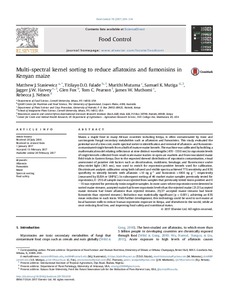| dc.contributor.author | Stasiewicz, Matthew |
| dc.contributor.author | Falade, T.D.O. |
| dc.contributor.author | Mutuma, M. |
| dc.contributor.author | Mutiga, Samuel |
| dc.contributor.author | Harvey, Jagger J.W. |
| dc.contributor.author | Fox, Glen |
| dc.contributor.author | Pearson, T.C. |
| dc.contributor.author | Muthomi, J.W. |
| dc.contributor.author | Nelson, Rebecca |
| dc.date.accessioned | 2019-12-04T11:07:48Z |
| dc.date.available | 2019-12-04T11:07:48Z |
| dc.date.issued | 2017-08-15 |
| dc.identifier.citation | Stasiewicz, M.J., Falade, T.D.O., Mutuma, M., Mutiga, S.K., Harvey, J.J.W., Fox, G., Pearson, T.C., Muthomi, J.W. and Nelson, R.J. 2017. Multi-spectral kernel sorting to reduce aflatoxins and fumonisins in Kenyan maize. Food Control 78:203–214. |
| dc.identifier.issn | 0956-7135 |
| dc.identifier.uri | https://hdl.handle.net/20.500.12478/1597 |
| dc.description.abstract | Maize, a staple food in many African countries including Kenya, is often contaminated by toxic and carcinogenic fungal secondary metabolites such as aflatoxins and fumonisins. This study evaluated the potential use of a low-cost, multi-spectral sorter in identification and removal of aflatoxin- and fumonisin-contaminated single kernels from a bulk of mature maize kernels. The machine was calibrated by building a mathematical model relating reflectance at nine distinct wavelengths (470–1550 nm) to mycotoxin levels of single kernels collected from small-scale maize traders in open-air markets and from inoculated maize field trials in Eastern Kenya. Due to the expected skewed distribution of mycotoxin contamination, visual assessment of putative risk factors such as discoloration, moldiness, breakage, and fluorescence under ultra-violet light (365 nm), was used to enrich for mycotoxin-positive kernels used for calibration. Discriminant analysis calibration using both infrared and visible spectra achieved 77% sensitivity and 83% specificity to identify kernels with aflatoxin >10 ng g−1 and fumonisin >1000 ng g−1, respectively (measured by ELISA or UHPLC). In subsequent sorting of 46 market maize samples previously tested for mycotoxins, 0–25% of sample mass was rejected from samples that previously tested toxin-positive and 0–1% was rejected for previously toxin-negative samples. In most cases where mycotoxins were detected in sorted maize streams, accepted maize had lower mycotoxin levels than the rejected maize (21/25 accepted maize streams had lower aflatoxin than rejected streams, 25/27 accepted maize streams had lower fumonisin than rejected streams). Reduction was statistically significant (p < 0.001), achieving an 83% mean reduction in each toxin. With further development, this technology could be used to sort maize at local hammer mills to reduce human mycotoxin exposure in Kenya, and elsewhere in the world, while at once reducing food loss, and improving food safety and nutritional status. |
| dc.description.sponsorship | Swedish International Development Cooperation Agency |
| dc.language.iso | en |
| dc.subject | Aflatoxins |
| dc.subject | Food Safety |
| dc.title | Multi-spectral kernel sorting to reduce aflatoxins and fumonisins in Kenyan maize |
| dc.type | Journal Article |
| dc.description.version | Peer Review |
| cg.contributor.crp | Agriculture for Nutrition and Health |
| cg.contributor.affiliation | Cornell University |
| cg.contributor.affiliation | University of Queensland |
| cg.contributor.affiliation | University of Nairobi |
| cg.contributor.affiliation | International Livestock Research Institute |
| cg.contributor.affiliation | United States Department of Agriculture |
| cg.coverage.region | Africa |
| cg.coverage.region | East Africa |
| cg.coverage.country | Kenya |
| cg.isijournal | ISI Journal |
| cg.authorship.types | CGIAR and developing country institute |
| cg.authorship.types | CGIAR and advanced research institute |
| cg.journal | Food Control |
| cg.howpublished | Formally Published |
| cg.accessibilitystatus | Limited Access |
| local.dspaceid | 82322 |
| cg.targetaudience | Scientists |
| cg.identifier.doi | http://dx.doi.org/10.1016/j.foodcont.2017.02.038 |

